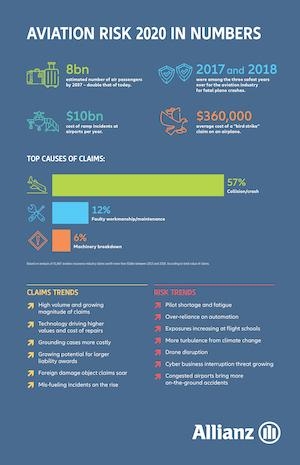Allianz And Embry-Riddle Release Findings From Aviation Risk Study
Despite record numbers of more than four billion passengers, the global airline industry has experienced some of its safest years in terms of fatal accidents, according to Aviation Risk 2020: Safety And The State Of The Nation published by the corporate and aviation insurance specialist Allianz Global Corporate & Specialty (AGCS) in association with Embry-Riddle Aeronautical University, the largest, fully accredited university specializing in aviation and aerospace.

The report, which analyzes more than 50,000 aviation insurance industry claims worth more than $16.3 billion from 2013 to 20181, reveals that collision/crash incidents currently account for over half the value of all claims (57%) equivalent to $9.3 billion – and over a quarter of claims by number (27%). More costly grounding and business interruption incidents resulting from cyber and drone events and more incidences of turbulence are just some of the trends expected to have an influence on the loss landscape.
Three of the past four years have been the safest ever for air travel. In 2017, for the first time in at least 60 years of aviation, there were no fatalities on a passenger jet flight, making it the safest year ever. Even 2018, which saw a total of 15 fatal airliner accidents with 556 victims, ranks as the third safest year ever, according to statistics from the Aviation Safety Network2, with 2015 ranked second. The lifetime chances of a person dying in a commercial aviation accident are extremely unlikely compared with other forms of transport such as by car or bicycle, as well as more unexpected scenarios such as accidental gun discharge or dog attack.
“The continuous improvement in aviation safety can be attributed to several factors, including design improvements, new technologies, more effective pilot training as well as significant improvements in manufacturing processes, aircraft operations and regulation,” explains Tom Fadden, Global Head of Aviation, AGCS.
Aerodynamic and airframe improvements, fly-by-wire aircraft and more effective safety inspections have had a dramatic impact on accident rates over the past decades. At the same time, engine manufacturers have almost eliminated the chance of engine failure. Radio and avionics are extremely precise today and improved air traffic control technology and better collision systems have also had a positive impact.
“Pilots now have much more live information at their fingertips while current navigation systems have the capability to determine an aircraft’s position to the thousandths of a mile,” says E. David Williams, Assistant Professor of Aerospace and Occupational Safety at Embry-Riddle Aeronautical University. “Improvements in science have also allowed the aviation industry to better understand how human factors can affect safety. Pilot fatigue, training, crew resource management and other factors have become increasingly important issues.”
The report also highlights a range of emerging risk scenarios, including:
- The projected demand for about 800,000 new pilots over the next 20 years – double the current workforce – brings challenges in recruitment and training, particularly in flight schools.
- Pilots’ overreliance on aircraft automation systems have resulted in accidents, highlighting the need for pilots to be better prepared to take manual corrective actions in the event of a technical malfunction.
- Incidences of turbulence are predicted to increase due to climate change with the North Atlantic flight passageway anticipated to see the greatest increase. Extreme turbulence can cause structural damage to aircraft, which can cost millions of dollars.
- The growing number of drones in the skies and cyber risks such as hacker attacks, systems outages and data breaches are also expected to have a significant impact on the aviation loss landscape.
- Accidents-on-the-ground remain problematic and could exacerbate. In many cases, airport infrastructure has not kept pace with the rapid growth in passenger and aircraft numbers. Crowded servicing areas and aprons are resulting in more collisions and ramp accidents. It is anticipated that the vast majority of the world’s busiest airports will likely see capacity issues within 10 years.
(Infographic provided with Allianz news release)
 ANN's Daily Aero-Term (04.20.24): Light Gun
ANN's Daily Aero-Term (04.20.24): Light Gun Aero-News: Quote of the Day (04.20.24)
Aero-News: Quote of the Day (04.20.24) ANN's Daily Aero-Linx (04.21.24)
ANN's Daily Aero-Linx (04.21.24) Aero-News: Quote of the Day (04.21.24)
Aero-News: Quote of the Day (04.21.24) ANN's Daily Aero-Term (04.21.24): Aircraft Conflict
ANN's Daily Aero-Term (04.21.24): Aircraft Conflict



